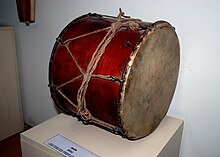Doli (drum)
Doli is a two-headed cylindrical tubular drum with a wooden body that is used in light music in Georgia .
Origin and Distribution
The polyphonic music of the Christian Georgians with sometimes complicated harmonic structures was strongly from about the 17th century by the entirely different kind monodically - modal dominated Persian music influences. The capital Tbilisi was the cultural center of all of Transcaucasia at that time . Some musical instruments have had names that come from Persian or Arabic for a much longer time and indicate a cultural exchange. Doli is likely derived from the Persian drum dauli . Dauli is also the name of a drum that Roma in Greece and Macedonia play together with the double reed instrument zurna to accompany the dance. In the Balkans, Roma maintain a tradition that is widespread across large parts of Asia in the interplay of these two instruments. The Georgian name doli corresponds to the word for drum dhol in Armenia , derived from the Persian duhul or duhal . In northern India the dhol is a large barrel drum. In Afghanistan, a dohol and the double reed sorna form an entertainment orchestra at family celebrations.
An old name for the same Georgian drum is dabdab-i , where -i is the noun ending characteristic of the Georgian language . The word is used in the epic The Warrior in a Tiger Skin by the Georgian national poet Schota Rustaveli (around 1172 - around 1216) and means there, for example, "drum" or " kettle drum ". Dabdabi can be traced back to the Arabic word dabdada via the Persian dabdabe with the corresponding meaning “drum” , whose older context includes “loud (with the feet)”, “beating noise”, “noise” and “bang”. From this the Arabic noun dabdāb for "drum" developed, which is exactly reproduced in Georgian.
The frame drum daira, played by women in Georgia ( dayereh in Iran , dāireh in Afghanistan ) is also related to the name of Arabic-Persian musical instruments . The Georgian kettle drum pair diplipito made of clay is a variant of the widespread naqqaras . In contrast to the doli , these two drums have largely disappeared from the country and can only be found in Armenia and Azerbaijan . The doli similar cylindrical drums in neighboring hot naghara in Azerbaijan and Baraban in Dagestan and Chechnya .
The doli is mostly played by men in urban popular music, in the past with mallets, now mostly with their hands. In the entertainment songs that were popular in Tbilisi at the end of the 18th century, indigenous Georgian styles mixed with the unanimous playing style of Persian and Turkish music : maqams were sung richly decorated with melisms . The singing voice was accompanied by the Turkish-Persian long-necked lute tari and sazi , the spit fiddle kamanca and the doli . In the same line-up, the Sazandar Ensemble played instrumental music (now a folk music trio in Azerbaijan that plays Mughams ). Today comes doli occasionally in Adjara in conjunction with the bagpipe chi bonuses , the single-reed instrument pilili or with the Georgian long-necked lute tschonguri (a slightly larger Panduri ) in dance music before. A city orchestra consists of several Armenian short oboes ( duduki ) and a doli . Usually two dudukis play together as a melody and drone instrument , supported by a drum. In ensembles with wind instruments, including the flute salamuri , the drummer often adds his singing voice.
Design
The uniformly cylindrical body consists of a thin-walled, hollowed-out wooden trunk, which is covered on both sides with an untanned animal hide. For this, the skins are pulled wet over an iron ring with a little excess, bent inwards and sewn after drying. The rings are a little larger than the diameter of the wood and are just above the edge. They are fixed at regular intervals with iron eyelets through which an endless cord is pulled that connects the two rings. Another cord is placed across the middle around the body and connected to the tension cords so that there is a Y-tension and the instrument can be tuned. The dimensions are different, the diameter is slightly larger or smaller than the height.
The doli player ( medole ) holds his instrument on his left thigh while sitting or standing by means of a cord around his neck, sometimes dancing along himself. Only one of the membranes is played with both hands or, less often, with sticks. In the middle, louder basic strokes can be produced with the palms of the hands, and finer intermediate strokes at the edge with the fingertips.
Web links
- Traditional Instruments and Music: Doli. ( Memento from January 16, 2013 in the Internet Archive ) openmuseum.org
- Doli. hangebi.ge
Individual evidence
- ↑ Farshid Delshad: Georgica et Irano-Semitica. Studies on the Iranian and Semitic loanwords in the Georgian national epic "The warrior in a panther's skin". (Ars poetica. Writings on literary studies 7; PDF; 3.1 MB) Deutscher Wissenschaftsverlag, Baden-Baden 2009, p. 124f, ISBN 978-3-86888-004-5
- ↑ Leah Dolidze, Christian Hannick u. a .: Georgia . In: Stanley Sadie (Ed.): The New Grove Dictionary of Music and Musicians . Vol. 9. Macmillan Publishers, London 2001, p. 677
- ^ Susanne Ziegler: Georgia. In: Music in the past and present . Sachband 3, 1995, Col. 1275-1278
- ^ Rustavi Dance Group - Georgian Doli (dhol) Player's. Youtube video

